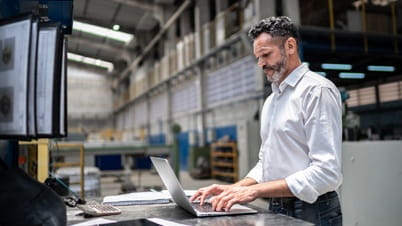Connected people, objects and processes, let smart cities provide efficient, safe and sustainable operations into the future.

Today, Internet of Things (IoT) devices and sensors are used in almost everything, everywhere. From the smartwatch on your wrist that monitors your health in real-time, to the smart metre in your home that records readings remotely, more and more pieces of our daily lives are getting connected.
And while the pace of urban development can take decades and even centuries, new technology innovations are spurring cities along. With the rapid urbanisation through the integration of new technologies such as IoT, cloud and Artificial Intelligence (AI), governments around the globe are on a mission to make cities connected, efficient, safe and sustainable.
The IoT game-changer
Urban living does not come without challenges. Being stuck in traffic at rush hour, garbage bins that always seem full, or broken streetlights that aren’t fixed for weeks can feel like everyday life. In an effective, connected smart city many of these inconveniences and inefficiencies can be alleviated.
In today’s world, municipal government services are typically scheduled and routine. Waste collection happens on a specific day every week, maintenance crews spot-check public equipment, such as streetlights, which means anything that might crop up in between inspections can get missed. However, as cities move to implement IoT technologies, services are becoming much more responsive and reactive.
IoT sensors installed on garbage bins, connected to a centrally managed platform, can alert the waste management company when the container is full. Instead of relying on bin collection at a set time, the waste-removal team can be dispatched when needed.
Similarly, if there is a problem with a streetlight with an IoT sensor, maintenance teams can be alerted immediately. Periodic spot checks will become a thing of the past as teams will be notified as soon as something needs fixing, saving time and keeping the streets well-lit and safe.
Managing the masses
Busy public transport and congested roads can make city travel difficult. As urban areas move to deploy connected sensors across the city, citizens can receive up-to-date information to help make informed travel decisions. Gridlock and overcrowding can be alleviated as people choose different routes or transportation options.
But it’s not just transportation that gets all tied up. Public buildings such as museums, galleries and government premises all experience busy periods. Using IoT sensors and asset tracking systems, organisations can detect how many people are in one place at one time. This can help manage visitor numbers as well as letting the public know how busy a site is. Organisations can use the same technology in commercial buildings, offices and healthcare locations, to track assets, reducing the time spent searching for items and the cost of replacing misplaced equipment.
Sustainability is top of mind
In addition to improving operational efficiencies, cities have a responsibility to meet global climate change targets through energy efficiency. Electric buses, subsidised public transport and congestion charges are commonplace in many urban areas to help drive behaviours and reduce vehicle emissions.
In addition to greener transport, cities must re-visit energy use in buildings. Installing IoT sensors in buildings lets organisations monitor the energy consumption of devices and control them remotely. With a centrally managed platform, hundreds of devices can be turned off simultaneously, reducing energy consumption and costs. With AI organisations can analyse collected data to detect anomalies and patterns that contribute to energy consumption. Based on findings, new practices can then be introduced to reduce emissions.
Safety first
With IoT technology and cloud-based solutions, governments and emergency services can monitor roads, streets and buildings in real-time.
CCTV IoT devices that are connected to a centrally managed platform can detect if there is an emergency, for example a car crash. In such an event, an alert is triggered to immediately notify emergency services. This technology saves time and lives.
IoT asset-tracking technology can also help increase safety by locating people and assets rapidly. Rescue teams can also remotely ensure a building is empty, saving them from entering a dangerous situation unnecessarily.
Reliable connectivity
Smart cities rely on 24/7 connectivity to function. Network outages are simply not an option. Downtime puts people at risk. Real-time data is key to the smart solutions cities demand. To ensure reliable connectivity, a city’s network should be centrally managed with high throughput and low latency. As technologies and network capabilities continue to evolve, networks will also need to be flexible and scalable to support innovations well into the future.
Smart technology in action
Our recent work with the island of Hokkaido (北海道) is a real-world example of how transformative smart technology and a dependable network can be to a community. Hokkaido is Japan’s second-largest island, situated in an earthquake-prone area. To ensure the safety of their elderly residents, the Information and Communication Infrastructure Utilisation Promotion Council (ICIUPC) is responsible for communication between eleven towns and villages.
Japan faces the potential for significant disruptions from natural disasters that can significantly impact its citizens. Older residents in remote towns who don’t have access to technology or connectivity can be particularly vulnerable.
In addition to disaster situations, everyday communication is essential to maintain people's health, which means providing connectivity to all the elderly residents. A cloud-based phone solution installed in residents’ homes enables them to communicate using video and audio. Hokkaido’s elderly community can also receive weather notifications, alerts from police and transportation operators, disaster warnings and updates, as well as have day-to-day consultations with healthcare professionals.
With this system, residents who have difficulties with public transport can also access on-demand transportation through a shuttle service. The solution protects isolated residents in instances of natural disasters, as well it aids the revitalisation of the local community, facilitating social integration with family, friends and other residents.
The Hokkaido Municipality has embraced digital technology. The robust network installed island-wide lets citizens enjoy reliable communications, protects their safety, and improves the general wellbeing of elderly citizens who now have a range of services at their fingertips.
Smart cities, ready for the future
As technology evolves so too will smart cities capabilities. A connected smart city enables governments to create cities and towns with services that work together seamlessly, to provide efficient, safe and sustainable operations. Ensuring cities have reliable, secure and scalable networks, means communities like Hokkaido can continue enjoying the benefits of the latest smart technology well into the future.
Latest Blogs

Supply chain resilience and business adaptability
Strategic supply chain resilience and business adaptability to thrive in the face of adversity

Solve education challenges with a modern campus network
A modern campus network helps streamline operations, reduce costs, and offers a safe and caring place to work and study.

Revitalise education with a modern campus network
A modern, campus-wide network upgrade aligns capabilities with academic, research and business priorities today and tomorrow.

Education today: Why modernising campus networks is a must
Educational institutions worldwide must modernise their networks to meet today’s new requirements.

